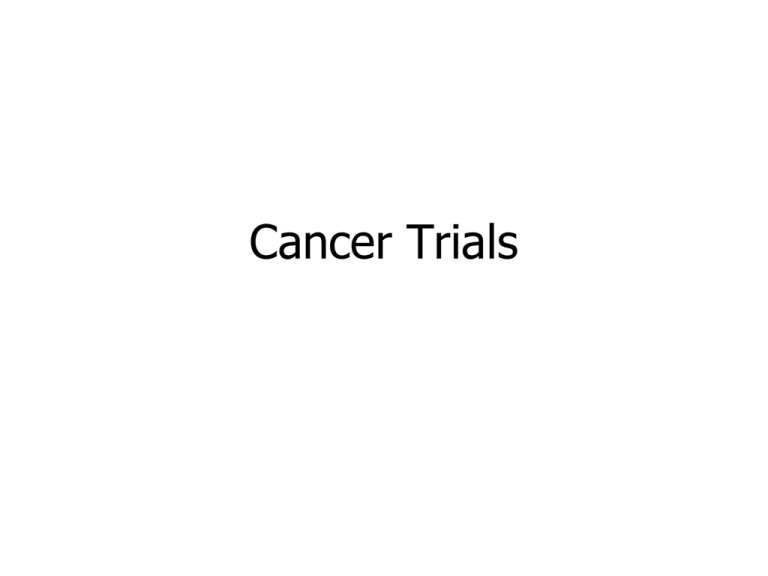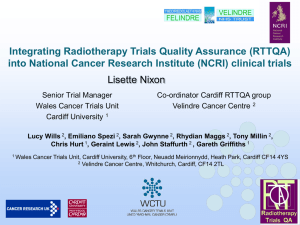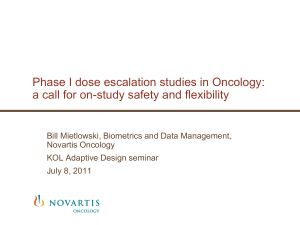
Cancer Trials
Reading instructions
•
•
•
•
•
•
•
6.1:
6.2:
6.3:
6.4:
6.5:
6.6:
6.7:
Introduction
General Considerations
Single stage phase I designs
Two stage phase I designs
Continual reassessment
Optimal/flexible multi stage designs
Randomized phase III designs
What is so special about
cancer?
The disease
•Many cancers are life-threatening.
•Many cancers neither curable or controlable.
•Malignant disease implies limited life expectancy.
The drugs
•Narrow therapeutic window.
•Many drug severely toxic even at low doses.
•Serious or fatal adverse drug reactions at high doses.
•Difficulty to get acceptance for randomization
Ethics
Some ways to do it
•No healty volunteers.
•Terminal cancer patients with short life expectancy.
•Minimize exposure to experimental drug.
•Efficient selection of acceptable drug.
The cancer programme
Phase I: Find the Maximum Tolerable Dose (MTD) The
dose with probability of dose limiting toxicity
less than p0
max d : Pd DLT p0
d D
Doses di , i 1,, I
Phase II:
DLT=Dose Limiting Toxicity
p0 often between 0.1 and 0.4
Investigate anti tumour actividy at MTD
using e.g. tumour shrinkage as outcome.
Sufficient anti tumour activity
Phase III: Investigate effect on survival
Phase I cancer trials
Objective:
Find the Maximum Tolerable Dose (MTD)
max d : Pd DLT p0
d D
PDLT p
p
x
ln
1 p
Use maximum likelihood to estimate and
p0
ˆ
ln
1 p
0
xm
ˆ
Phase I cancer trials
Design A
If
di is the highest dose
then d i 1 is the estimated MTD
•Only escalation possible.
•Start at the lowest dose.
•Many patients on too low dose.
Start with a group of 3
patients at the initial
dose level
No toxicity
Yes
Next group of 3 patients
at the next higher dose level
No
Next group of 3 patients
at the same dose level
Toxicity in at most
one patient
No
Trial stops
Yes
Next group of 3 patients
at the next higher dose level
Phase I cancer trials
Start with a single
patient at the initial
dose level
Design B
•Escalation and deescaltion possible.
•No need to start with the lowest dose.
p0
ln 1 p ˆ
0
MTD: xm
ˆ
Yes
No
Next patient at the next
lower dose level
No Toxicity in two
consequtive patients
No
Next patient at the next
lower dose level
Next patient at the
same dose level
No toxicity
Yes
Toxicity in two
consequtive patients
No
Trial stops
Yes
Next patient at the next
higher dose level
Phase I cancer trials
Design D
•Escalation and deescaltion
possible.
•No need to start with the
lowest dose.
p0
ln 1 p ˆ
0
MTD: xm
ˆ
Start with a group of 3
patients at the initial
dose level
Toxicity in more
than one patient
Yes
Next group of 3 patients
at the next lower dose level
No
Toxicity in one
patient
No
Next group of 3 patients at
the next higher dose level
Repeat the process until
exhaustion of all dose levels
or max sample size reached
Yes
Next group of 3 patients
at the same dose level
Phase I cancer trials
Design BD
Run design B
until it stops.
DLT in last patient
Run design D
starting at same
dose level.
Run design D
starting at the next
lower dose level.
Phase I cancer trials
Continual reassessment designs
p0 Acceptable probability of DLT
MTD
d 0 max d : Pd DLT p0
d D
Dose response model:
logitPxi , xi
Assume fixed.
Let g be the prior distribution for the slope parameter.
Phase I cancer trials
Once the response, DLT or no DLT, is available
from the current patient at dose xi 1 the estimated slope is update as:
i E | i 1 f | i 1 d
where
f | i 1
where
qi1 g
q z g z dz
i 1
i 1
qi1 Px j , j 1 Px j ,
j 1
y
i 1 x1 , y1 ,, xi 1 , yi 1
1 y j
is the likelihood function, and
is the cumulative data up to the i-1 patient.
Phase I cancer trials
The next dose level is given by minimizing
Pxi , i p0
MTD is estimated as the dose xm for the hypothetical n+1 patient.
The probability of DLT can be estimated as
Pxm , m
•CRM is slower than designs A, B, D and BD.
•Estimates updated for each patient.
•CRM can be improved by increasing cohort size
Phase II cancer trials
Objective: Investigate effect on tumor of MTD.
Response: Sufficient tumour shrinkage.
Progression free survival.
Two important things:
•Stop developing ineffective drug quickly.
•Identify promising drug quickly.
Phase II cancer trials
Optimal 2 stage designs.
First stage:
n1 patients:
Second stage: n2 patients:
Unacceptable response rate:
Acceptable response rate:
Test:
p0
p1
Stop and reject the drug if at
most r1 successes
Stop and reject the drug if at
most r successes
p0 p1
H0 : p p0 vs. H1 : p p0
PT ypeI error
PT ypeII error
Phase II cancer trials
How to select n1 and n2 ?
Minimize expected sample size under H0: EN n1 1 PETp0 n2
n1
where PETp0 p0 1 p0 Br1; n1 , p0 is the
i 1 i
r1
probability of early termination.
Pp0 (reject drug) Br1; n1 , p0
min(n1 , r1 )
bx; n , p Br x; n , p
x r1 1
1
0
1
1
0
Given p0, p1, and , select n1, n2, r1 and r such that
EN n1 1 PETn2 is minimized.
Nice discrete problem.
Phase II cancer trials
Assume specific values of p0, p1, and
For each value of the total sample size n, n1[1,n-1] and r1[0,n1]
Find the largest value of r that gives the correct PT ypeII error
Check if the combination: n1, n2, r1 and r satisfies PT ypeI error
If it does, compare E[N] for this design with previous feasible designs.
Start the search at
p1 p0
p1 p2 z1 z1
1
2
2 p1 p0
!: not unimodal
2
Phase II cancer trials
Optimal 2 stage designs with:
PT ypeI error 0.05 PT ypeII error 0.20
Efficacy hypotheses
p0
p1
0.05
0.25
0.30
0.50
0.70
0.90
r1/n1
0/9
5/15
4/6
Reject drug if
r/n
2/17
18/46
22/27
E[N]
12.0
23.6
14.8
PET
0.63
0.72
0.58
Corresponding designs with minimal maximal sample size
Efficacy hypotheses
p0
p1
0.05
0.25
0.30
0.50
0.70
0.90
Reject drug if
r1/n1
r/n
0/12
2/16
6/19
16/39
19/23
21/26
E[N]
13.8
25.7
23.2
PET
0.54
0.48
0.95
Phase II cancer trials
Optimal flexible 2 stage designs.
In practise it might be difficult to get the sample
sizes n1 and n2 exactly at their prespecified values.
Solution: let N1{n1, …n1+k} with P(N1=n1j)=1/k, j=1,…k
and N2{n2, …n2+k} with P(N2=n2j)=1/k , j=1,…k.
N1 and N2 independent, n1+k< n2.
P(N1=n1j ,N2=n2j)=1/k2 , j=1,…k.
Total samplesize N=N1+N2
Phase II cancer trials
For a given combination of n1 +i and n2 +j:
EN n1 i 1 PETp0 n2 j
n1 i
p0 1 p0 Br1; n1 i, p0
i
i 1
where PETp
0
r1
Minimize the average E[N]
(Average over all possisble stopping points)
Phase II cancer trials
Flexible designs with 8 consucutive values of n1 and n2.
PT ypeI error 0.05 PT ypeII error 0.20
Efficacy hypotheses
p0
p1
0.05
0.25
0.30
0.50
0.70
0.90
Reject drug if
r1/n1
r/n
0/5-10, 1/11-12
2/17-21, 3/23-24
3/11, 4/12-14
16/40-41, 17/42-44
5/15-16, 6/17-18
18/45-46, 19/47
4/6, 5/7, 6/8, 7/9,
22/27, 23/28-29,
8/10-11, 9/12, 10/13
24/30, 25/31,
26/32-33, 27/34
E[N]
11.8
24.0
PET
0.73
0.68
15.2
0.74
Phase II cancer trials
Optimal three stage designs
The optimal 2 stage design does not stop it there is a
”long” initial sequence of consecutive failures.
First stage: n1 patients:
Stop and reject the drug if no successes
Second stage: n2 patients:
Stop and reject the drug if at most r2 successes
Third stage: n3 patients:
Stop and reject the drug if at most r3 successes
For each n1 such that:
1 p1 n
1
Preject Ha | p1
Determine n2, r2, n3, r3 that minimizes the expected sample size.
More?
Phase II cancer trials
Example:
Optimal 3 stage design with n1 at least 5 and
PT ypeI error 0.05 PT ypeII error 0.20
Efficacy
hypotheses
p0
p1
0.05
0.25
0.30
0.50
0.70
0.90
Reject drug if at least
r1/n1
0/7
0/5
0/5
r2/n2
1/15
5/15
4/6
r3/n3
3/26
19/49
22/27
E[N]
10.9
22.5
14.8
Stage 1
Overall
PET
0.70
0.17
0.00
PET
0.87
0.73
0.58
Phase II cancer trials
Multiple-arm phase II designs
Say that we have 2 treatments with P(tumour response)=p1 and p2
Select treatment i for further development if
pˆ i pˆ j
Ambiguous if
pˆ i pˆ j
Assume p2>p1. The probability of correct secection is
PCorr P pˆ 2 pˆ 2 | p1, p2
n n x
n x
n y
I x y n p2 1 p2 p1y 1 p1
x 0 y 0
x y
n
n
Phase II cancer trials
The probability of ambiguity is
Ambiguous if
pˆ i pˆ j
PAmb P pˆ 2 pˆ 2 | p1, p2
n
n
n n x
n x
n y
y
I x y n p2 1 p2 p1 1 p1
x 0 y 0
x y
Phase II cancer trials
Select n such that:
PCorr PAmb
Probability of outcomes for different sample sizes (=0.05)
n
50
50
75
75
100
100
P1
0.25
0.20
0.25
0.20
0.25
0.20
P2
0.35
0.35
0.35
0.35
0.35
0.35
PCorr
0.71
0.87
0.76
0.92
0.76
0.94
PAmb
0.24
0.12
0.21
0.07
0.23
0.06
PCorr+0.5PAmb
0.83
0.93
0.87
0.96
0.87
0.97
Phase II cancer trials
Sample size can be calculated approximately by using
PCorr P Z
Where
Z ~ N 0,1
The power of the test of
PAmb P Z
P
Z
p2 p1
1
p1 1 p1 p2 1 p2
n
H0 : p1 p2 vs. H1 : p1 p2
is given by
p2 p1
p2 p1
1 1 Z / 2
Z / 2
Z / 2
is the upper /2 quantile of the standard normal distribution
Phase II cancer trials
Letting
PCorr PAmb
it can be showed that:
1 Z / 2
Sample size can be calulated for a given value of .
P1
0.05
0.10
0.15
0.20
0.25
0.30
0.35
0.40
P2
0.20
0.25
0.30
0.35
0.40
0.45
0.50
0.55
=0
=0.90
32
38
53
57
71
73
75
76
=0.80
13
15
17
19
31
32
32
33
=0.5
=0.90
16
27
31
34
36
38
46
47
Phase II cancer trials
Many phase II cancer trials not randomized
Treatment effect can not be
estimated due to variations in:
•Patient selection
•Response criteria
•Inter observer variability
•Protocol complience
•Reporting procedure????
•Sample size (?)
Phase III cancer trial
It’s all about survival!
Diagnosis
•Progression free survival
•Cause specific survival
•All cause survival
Treatment
Progression
Death from
the cancer
Death from
other causes
The competing risks model
D (t )
Death cused by D
Diagnosed with D
D (t )
Death from
other cause
tot (t ) D (t ) D (t )
The aim is to estimate the cause specific survival
function S D (t ) for death caused by D.
The usual way
The cause specific survival, S D (t ), is usually estimated using
the cause of death information and standard methods such
as Kaplan-Meier or life tables, censoring for causes of death
other than D.
Problem: The actual cause of death is not always
equal to the registered cause of death.
The model :
tot (t ) D (t ) D (t )
can be formulated using the corresponding
survival functions as:
Stot (t ) S D (t ) * S D (t )
using
t
S. (t ) exp . (u )du
0
Estimate: SˆD (t ) Sˆtot (t ) / SˆD (t )
Estimation
Stot (t ) can be estimated directly from data.
SD (t ) relating to deaths from causes other than D
can be estimated using data from a population registry if:
D is a ‘rare’ cause of death in the population.
The study population has the same risk of dying
from other causes as the background population.
SD (t ) : the “expected” survival given age,
sex and calender year
The intuitive way (no
formulas)
• We have the annual survival probability
given age, sex and calender year.
• Multiply to get the probability of
surviving k years for each individual
• Average to get the expected survival.
Converting intuition into formulas
Individuals i=1 …n, time intervals j=1 to k
For each individual we have the “expected” probability Pi (t j )
of surviving time interval j.
j
1
I
ˆ
S D (t j ) Pi (th )
n i 1 h1
n
Now
is called the Ederer I estimate of the expected survial
Problemo
age
at
risk
at tj
91
95
88
82
85
77
74
72
72
73
70
66
63
tj
t
tj+1
All inividuals contributes to
I
ˆ
S D (t j )
Only individuals at risk at tj contributes to
Sˆtot (t j )
Solution:
Let only individuals at risk contribute to the expected survival.
n
1
II
ˆ
S D (t j )
1{iI (th )} Pi (th )
h 1 n(t h ) i 1
j
where n(t ) is then number of individuals at risk at time t.
and I (t ) is the index set of individuals at risk at time t
The Ederer II estimate
Expected survival for a group pf
patients diagnosed with prostate
cancer 1992
Ederer I and Ederer II expected survival
Expected survival
1
0.9
0.8
0.7
0.6
0.5
0.4
0.3
Ederer I
0.2
0.1
Ederer II
0
0
1
2
3
4
5
6
Time from diagnosis (years)
7
8
9
10
Estimated cause specific survival of
patients diagnosed with prostate
cancer 1992
1
0.9
cause specific survival
0.8
0.7
0.6
0.5
0.4
0.3
Ederer II
0.2
Life table
0.1
0
0
1
2
3
4
5
Time from diagnosis (years)
6
7
8
Continuous time, expected
hazard
*i (t ) : ‘expected’ morality (hazard) from the population
for individual i.
Yi (t ) : at risk indicator for individual i at time t.
Y (t ) Yi (t ) : number of individuals at risk
i
The expected integrated hazard is now given by
t
n
Yi (u )
A (t ) (u )
du
Y (u )
0 i 1
*
*
i
Cont. time relative survival
Rewriting the model: tot (t ) D (t ) D (t )
t
using integrated hazards we can estimate
D
(u ) du using
0
=event times
X
,
X
,...
D
1
2
i
Aˆ D (t )
A* (t ) where
Di = # events at time X i
X i t Y ( X i )
Now the continuous time relative survival is given by:
ˆ (t )
S
tot
SˆD (t )
exp Aˆ D (t )
Illustrated
1* (t )
*2 (t ) *
3 (t )
*
4 (t ) *
1 (t )
t
Illustrated
(t )
*
1
(t )
*
*2 (t ) *
3 (t )
*
4 (t ) *
1 (t )
t
Example
Example
Population based trials
In many countries there are cancer registers where data
on all cases of cancer diagnoses are collected.
Many countries also have a cause of death registry
Intervension
Incidence
Death
Incidence
Intervension
Death
Often observational studies i.e. no randomization.











